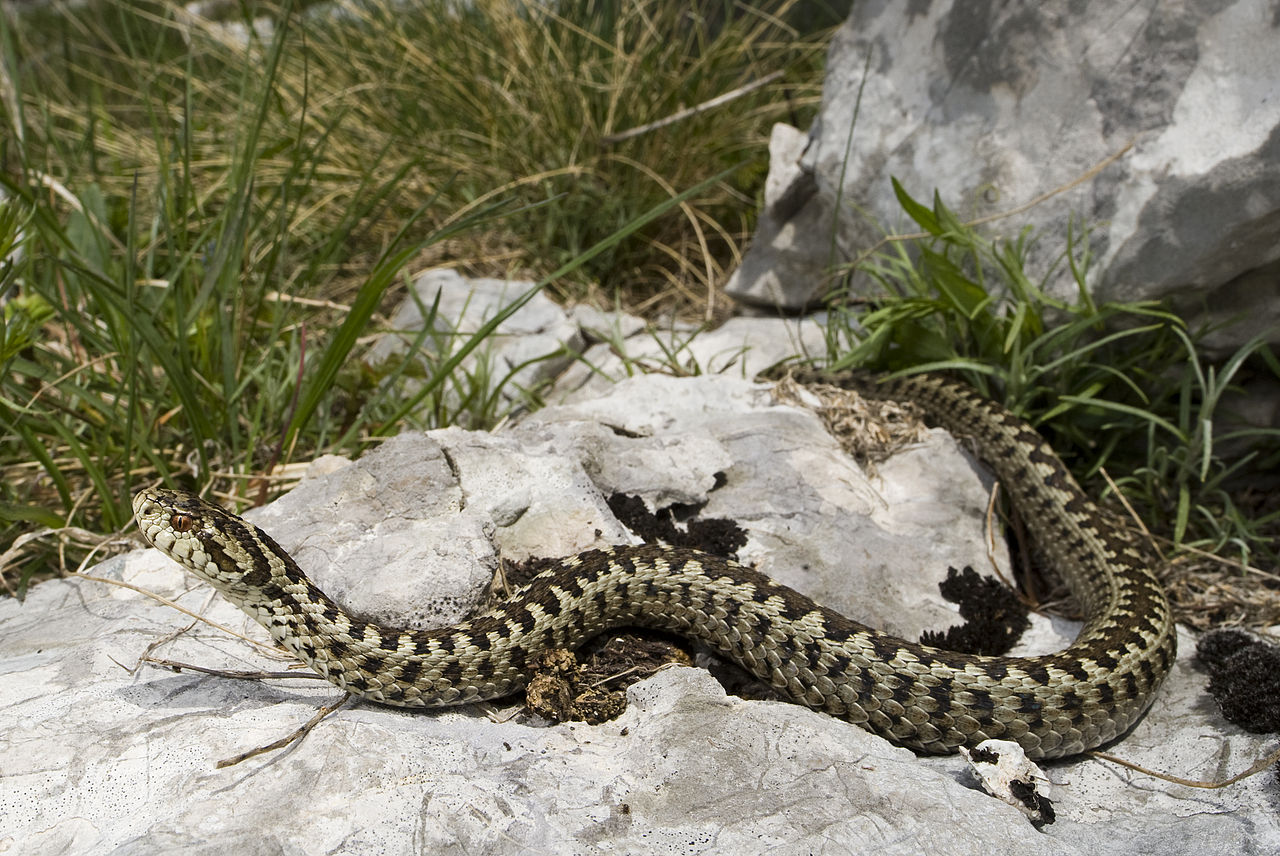

Another, not so pleasant representatives of Georgian fauna. However, as with other animals, they will rather scare you than actually do some harm as they are shy and avoid humans whenever possible.
The most common snake occuring in Georgia is non-poisonous “ring snake”. It has a grey, unremarkable body, but can be easily identified thanks to the white stripe around his neck (as if he had a ring stuck around it ).
The only snakes in Georgia dangerous to humans are vipers - they can be recognized by a typical dark zig-zag stripe on his back . It´s possible to encounter 3 species:
Caucasus viper (vipera kaznakovi) - endemic to Caucasus, endangered and very rare. Grows up to 75cm. Can be found in the wetter mountain areas such as Svaneti or Adjara.
Lebetine viper (macrovipera lebetina)- large, blunt nosed viper, grows up to 1,5m. Lives mostly in dry, rocky areas of southeastern Georgia such Vashlovani National Park or around Davit Gareja.
Meadow viper (vipera ursinii) - this most widespread species of the viper can be found also in Georgia. Smallest of all vipers, it grows only up to 50cm.

Meadow viper
How to prevent a snake bite? Usually, no effort is needed, snakes are shy and prefer to “run” away. They attack only if they feel directly threatened. Still, you can reduce this risk by few simple measures.
The most effective of them are those most simple ones - watch your step and don’t stick your hands into narrow, dark crevices unless necessary.
Also, consider wearing sturdy hiking boots and long pants. Personally, I am often too lazy to wear them, but they are strongly recommended for more vulnerable categories such as children or pregnant women.
Very useful are also trekking sticks. They generate strong vibrations (which alert snakes to your presence and gives them more time to hide) and at the same time “scan” the area in front of you
(so a snake could attack a pole instead of you).
First of all - forget what you saw in the movies. Don’t apply a tourniquet - it keeps all venom in one place which can cause a major damage to the tissue and lead to amputation. Sucking the wound, cutting it, licking or whatsoever doesn’t help at all and in some cases can even speed up the poisoning.
So what you should do? The recommended treatment of snakebite is actually pretty simple. Your main objective is to slow down the absorbtion of the poison - venom spreads faster if the heart rate of the victim is high. Therefore, victim shouldn’t undertake any physical activity. Also, try to calm him down - panic will increase the heart rate.
To calm a victim, remind him, that even though viper’s bite is certainly unpleasant, it’s rarely fatal. To kill an adult human, about 15mg of viper’s venom is needed, but viper can’t store more than 10mg. And what’s even more important, viper usually saves this venom for a prey it can eat such as rodents or small mammals. It takes several weeks to accumulate a full supply of venom and the snake can´t afford to waste it all on a human. So there is a solid chance that even if the viper bit you, it didn't release any venom at all.
Treatment of the wound - let it bleed for a few minutes, this way, it cleans itself. Then gently cover it with a cloth. Remove all constricting items such as rings or shoes which could become too tight once the bitten area swells. Then fix the limb with a splint - it should move as little as possible.
If it´s possible to transport the victim to the hospital, it should be done immediately. If you are stuck out in the wilderness without phone reception, it´s probably better to camp, let the victim rest and send someone for help.
As you can see above, trekking in Georgia is not particularly risky compared to the rest of the world. Still, it would be reckless to travel without an insurance (I think you already see where is this going - I would be a very lousy travel blogger if I didn't try to sell you some travel insurance ). During the last 10 years I spent hiking and trekking, I used two insurances.
When I was younger, I used to have more time and could make several long trekking trips a year. My main priority was to protect myself and my relatives from unexpected costs. Because of this, I used to be a member of Austrian Alpine Club (Alpenverein). After paying the yearly membership fee of about 60 EUR, I got an insurance tailored for mountains which covered rescue costs, medical treatment as well as the repatriation costs (tho my parents didn´t look too relieved when I stressed this fact before travelling abroad).
Then my priorities shifted. Since I have a family now, I spend less time hiking and need an insurance which not only covers everything mentioned above but will also provide for them in case that something happens to me. Because of this, I started to look for more general insurance for specific dates. For my summer trekking trips, I use SafetyWing travel insurance since I am very satisfied with the coverage it offers for its cost.
SafetyWing also offers Remote Health - a more robust, full-fledged health insurance which, unlike their travel insurance covers also home country and pre-existing conditions and illnesses.
Disclaimer: Those SafetyWing links are the affiliates. That means that if you click it and buy some insurance from them, I will get a small comission. But that's not why I am promoting them, they simply look the best to me (compared it with local insurance companies as well as global ones such as World Nomads).
